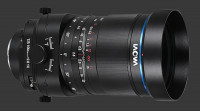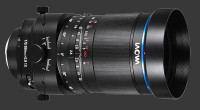Good EVFs are Good and Bad EVFs are Bad
News
2013.05.27
Viewfinders vary widely and, even within the same type of viewfinder, the experience still varies. Among optical reflex viewfinders, the difference between the best and the worst OVF is easily visible but does not impair working that much. The same cannot be said about electronic viewfinders. It may sound obvious but:
Good EVFs are very good and bad EVFs are really bad
For this reason, it is crucial to know how well an EVF works. Unfortunately, specifications alone only tell a very minor part of the story and one had to read camera reviews which pay attention to viewfinder-ergonomics if you cannot try the camera in various conditions yourself. Here are differences to pay attention to:
- Resolution: EVFs exist with resolutions of 115,000 pixels all the way to 2.4 megapixels. This makes a significant difference in showing fine-details. Anything below 1 MP generally spells trouble. At 1.4 MP and up, one can at least see when a camera has focused properly or not. This number is almost always quoted in camera specifications.
- Size: Various sizes of EVFs from 0.2" to 0.5" are used in digital cameras. This is the physical size of the viewfinder. However, an optical element in front of it may provide some magnification. For this reason, comparing viewfinder size is not exact yet it remains a good indicator. A large viewfinder, at least 0.4" diagonally, makes it much easier to identify small details. When taking photos of people, animals or other changing objects, this can greatly help to see when no one is blinking and expressions are good. EVF size is frequently specified.
- Magnification: This number relates the perceived size of the viewfinder relative to the camera's sensor-size. Dividing the magnification by the crop-factor gives an absolute measure of apparent-size. Anything above 0.6X, so 1.2X on a Four-Thirds camera, or 0.9X on an APS-C one, shows a large and bright view. As a comparison point, top-of-the-line full-frame DSLRs have a viewfinder with 0.7X or more of magnification. See DSLR viewfinder sizes for more examples. This number is seldom quoted.
- Dynamic-Range: The dynamic-range of an EVF affects its usability when faced with high-contrast scenes. Ideally, the DR of the EVF should match or exceed that of the sensor. When the DR is too low, some part of the scene will appear over-exposed or under-exposed without being so. Crucially, one is not capable watching what happens in areas where the EVF does not show any details. This is illustrated in Luminous Landscape's Why I Hate EVFs.
- Brightness: As a viewfinder, an EVF's sole purpose is to let one frame subjects. In normal daylight conditions and typical household lighting, EVFs are easily capable of showing the scene clearly. When light levels are low, an EVF must be able to amplify the signal to maintain the preview sufficiently bright. The best EVFs can do so remarkably well and even amplify the image so that it is more visible than with the naked eye. This makes them usable even with a strong ND filter which OVFs cannot handle. On the other hand, poor EVFs become dim in low-light which makes the camera useless for such conditions. Those who intend to shoot in low-light must therefore know if an EVF can hold up.
- Lag: By its nature, an OVF is updated at the speed-of-light. EVFs are updated by reading the sensor and processing the RAW signal into a digital preview. The time it takes for this to happen causes a lag and is of great concern to action photographers. The latest generation of high-end EVF can update at up to 120Hz which makes for a very short lag. However, this lag is not fixed. In low-light conditions, most EVFs slow down to refresh rate in order to provide a bright display with less grain. This compromise is fixed on a digital camera, so some will produce less grain and more lag, while others will show more grain and less lag.
- Refresh Rate: An EVF is updated periodically, usually at between 15 and 120 Hz. A faster refresh-rate means a shorter lag and vice-versa. Action photographers should look for ones with high refresh-rates. Just as the lag is variable, so is the refresh-rate, so things nearly always slow down in low-light.
- Exposure-Priority: EVFs are very advantageous in that they can show a relatively accurate preview of how an image will be exposed. When they work this way, they are said to be Exposure-Priority. This is really nice to have and greatly reduces the need to check shots after they are taken. It also makes it clear when a change of exposure is needed. Keep in mind that Exposure-Priority is impossible when using flash, so most EVFs revert to Display-Priority when the camera thinks the flash will fire. Display-Priority shows a bright image regardless of exposure, so be sure to check shots regularly to avoid surprises. Unfortunately, not all cameras are Exposure-Priority even when they could be and some are neither that nor Display-Priority, rendering the view mysterious at best.
- HUD: This is a bonus feature of EVFs. A good EVF, combined with well thought-out camera ergonomics, lets the camera be completely operated at eye-level. At least one should be able to see a good amount of information on the EVF, including exposure-parameters, battery-status, digital-levels, image-parameters and other modes. The flip-side of this is that some EVFs show too much information and watching the edge of the frame for proper framing becomes quite difficult.
If we were not worried about EVFs before, this should give you plenty of reasons! It pays and will remove plenty of frustrations to read about how a camera's EVF performs. At the same time, one can also see how far the very best EVFs have come since their invention.
- Digital Camera
Please Support Neocamera
All information on Neocamera is provided free of charge yet running this website is a huge endeavor. Purchases made via affiliate links found throughout the site help keep it running and up-to-date. There is no additional cost to you, so please consider buying via these links to our affilates:
If you found any information on this site valuable and did not purchase via our affiliate links, please considering donating via PayPal:
Any amount will be greatly appreaciated. Thank you for your support!
New Cameras & Lenses

Venus Optics Laowa 100mm F/2.8 Tilt-Shift 1X Macro
Sony E Mount Prime Lens
2024-12-17
Venus Optics Laowa 100mm F/2.8 Tilt-Shift 1X Macro
Nikon Z Mount Prime Lens
2024-12-17
Venus Optics Laowa 100mm F/2.8 Tilt-Shift 1X Macro
Leica L Mount Prime Lens
2024-12-17
Venus Optics Laowa 100mm F/2.8 Tilt-Shift 1X Macro
Canon RF Mount Prime Lens
2024-12-17
Venus Optics Laowa 100mm F/2.8 Tilt-Shift 1X Macro
Fujifilm G Mount Prime Lens
2024-12-17
Venus Optics Laowa 55mm F/2.8 Tilt-Shift 1X Macro
Fujifilm G Mount Prime Lens
2024-12-17
Updates
2024.11.18

Best 2024 Photography Gifts for Every Budget
Great gifts for photographers and photo enthusiasts selected for every budget among the best products of 2024.
2024.08.07

Eye Protection Tips for Professional Photographers
The four main considerations for professional photographers regarding eyewear.
2024.07.14

Fujifilm X100VI Review
Flagship fixed-lens compact digital camera with a 40 MP sensor and Image-Stabilization, a first for the series. Retro design featuring dual control-dials, plus direct ISO, Shutter-Speed and EC dials. Its hybrid viewfinder can switch between EVF and OVF mode.
2024.05.09

Fujifilm GFX100 II Review
Flagship 102 Megapixels Medium-Format Mirrorless Digital Camera with 8-Stop 5-Axis IBIS, 8 FPS Drive, 8K Video and 400 MP Super-Resolution capture in a weatherproof and freezeproof body with dual control-dials and dual memory-card slots.
2024.04.03

Fujifilm X-T5 Review
Newest Fujifilm flagship boasting a 40 MP APS-C sensor, 5-axis IBIS with 7-stop efficiency, 15 FPS continuous drive, 6.2K Video capture, dual control-dials and dual SDXC UHS-II slots in a sturdy weatherproof and freezeproof body.
2023.11.20

Best Digital Cameras of 2023
Find out which are the Best Digital Cameras of 2023. All the new Mirrorless Digital Cameras from entry-level to high-end professional.
2023.07.10

Fujifilm X-H2 Review
40 Megapixels APS-C Hybrid Mirrorless Digital Camera with 7-stop IBIS. Fastest shutter ever and 8K video capture. Large builtin EVF with 0.8X magnification and 5.8 MP, plus an Eye-Start Sensor. Packed with features and large number of controls in a weatherproof and freezeproof body.
2023.05.07

Sony FE 20-70mm F/4G Review
Review of the unique Sony FE 20-70mm F/4G lens. The optical zoom of this lens spans ultra-wide-angle and medium focal-length coverage, making it one of the most versatile Full-Frame lenses on the market.
2023.01.15

Huion Inspiroy Dial 2 Review
Review of the Huion Inspiroy Dial 2 tablet, a medium sized drawing surface with dual dials and customizable buttons. Connects via USB-C or Bluetooth 5.0 with Windows, Linux and Android support.
2022.12.08

How to Pack for a Photo Trip
Find out how to pack for a travel photography trip, carry your gear safely while meeting airline regulations.
2022.11.13

Best Digital Cameras of 2022
The best digital cameras of 2022. A short list of the most outstanding models in their respective categories. Choose one for yourself or as a gift.
2022.09.21

Pentax DA* 60-250mm F/4 SDM Review
Review of the Pentax DA* 60-250mm F/4 SDM, the constant-aperture telephoto zoom with the highest zoom-ratio on the market.







